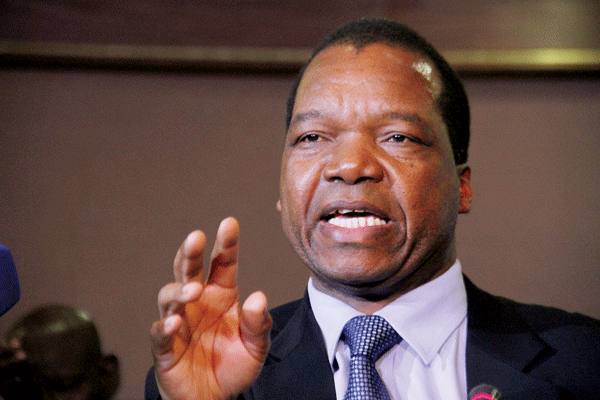
By Andrew Lampard
THE interbank market, revived by the Reserve Bank of Zimbabwe (RBZ) recently, has gotten off to a slow start because the majority — if not all the banks — are still in the process of putting their systems in place.
In its monetary policy statement (MPS) of February 20, 2019, the central bank allowed the RTGS dollar — an amalgamation of the bond note, bond coin and the virtual Real Time Gross Settlement — to float on the interbank market, where the forces of demand and supply shall determine the exchange rate.
The policy change signalled a bold step in the right direction for the RBZ which, despite its noble intentions, had found market developments of the past seven months too radical to ignore by maintaining the 1:1 parity between the United States dollar (USD) and the bond note.
Business, which holds the key for economic revival in Zimbabwe, has thrown its full weight behind RBZ governor Dr John Mangudya’s MPS because it removes unwarranted interference by state actors in the workings of market forces, mostly for political reasons which are usually in conflict with economic rationality.
The generality of the population, except for the handful that flourish on arbitrage opportunities, also welcomed the MPS — inspite of the pain of adjustment that comes with it — because it has brought about predictability in the currency market and lowers the risk they faced in accessing foreign currency (forex) from the illegal parallel market where upon being caught, one faces up to 10 years in the country’s overcrowded prisons, where conditions are deplorable.
To the RBZ’s credit, the RTGS dollar has managed to trade within the range it had anticipated. Who knows, with the start of the tobacco-selling season last week, the rate may firm up — a distant possibility though.
Why is that possibility remote?
- Chamisa under fire over US$120K donation
- Mavhunga puts DeMbare into Chibuku quarterfinals
- Pension funds bet on Cabora Bassa oilfields
- Councils defy govt fire tender directive
Keep Reading
Just like with any policy — no matter how brilliant — it can only succeed if the transmitters of that policy and the market actors play their part in realising its objectives.
This has not always been the case in Zimbabwe’s heavily polarised environment where the greater good is often drowned by varying political, sectional and — at times — myopic interests.
After the MPS was presented on February 20, 2019, it was given that the floating of the currency on the interbank posed an immediate threat to illegal forex dealers who used to depend on the black market to put food on their tables.
Naturally, dealers wouldn’t want to see the MPS succeed because it shuts the doors for rent-seeking behaviour, abhorred for creating market distortions.
It is also quite obvious for the few who were accessing forex at 1:1 to wish for the MPS to sink in the hope that the old order could be reinforced.
The strange criticism that Mangudya got from Parliament’s Public Accounts Committee led by Tendai Biti recently also exposes the disquiet in the opposition, including amongst some in the ruling Zanu PF party, judging by the slant and character of the debate.
While the resistance from these quarters is expected, what is coming out as a surprise is the lethargy by banks to quickly put their houses in order so as to support the interbank market, which opens another window of opportunity for them to make money from forex trading and ensuring that their clients get all they need under one roof.
Understandably, the monetary authorities could not have alerted the banks to prepare their systems in advance without undermining their own policy in the event that such information was to leak into the market prior to the presentation of the MPS. The logical thing, which is what the RBZ did on February 20, 2019, was to surprise the market.
By introducing these measures, the RBZ and the Finance ministry have once again taken leadership in driving the market instead of reacting and playing catch-up. This opportunity could slowly slide away if the banks take forever to operationalise the policy.
Unfortunately, the consequences may be dire.
As the RBZ continues to fine-tune its measures by continuously looking into what could go wrong and devising supporting or mitigating measures, it must consider a set of measures to push banks into investing in the requisite software and hardware, as well as identifying and training the right staff to operate the interbank market.
The longer it takes to do meaningful trade on the interbank market, the more difficult it will be for the RBZ and the banks themselves to assert their authority in the market.
It would be sad if the banks allow those who have been thrown into disarray by the RBZ measures to re-group, fight back and put asunder such progressive policy.
Already, there are unhelpful lines of argument giving away these retrogressive intentions like: “How did the bank come up with the 2,5 rate? Why is the rate being kept at that level? Was it not better to set it above the parallel market level or at the same level?”
Really!
In conclusion, the banking industry must adopt an effective, inside-out communication strategy to support policy.
Currently, the feeling is that banks seem to engage more externally than internally or within their institutions and end up missing on critical information key to resolution of challenges.
Andrew Lampard is a retired banker who worked in Zimbabwe and South Africa. For views and comments, e-mail to [email protected]











